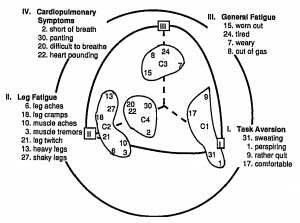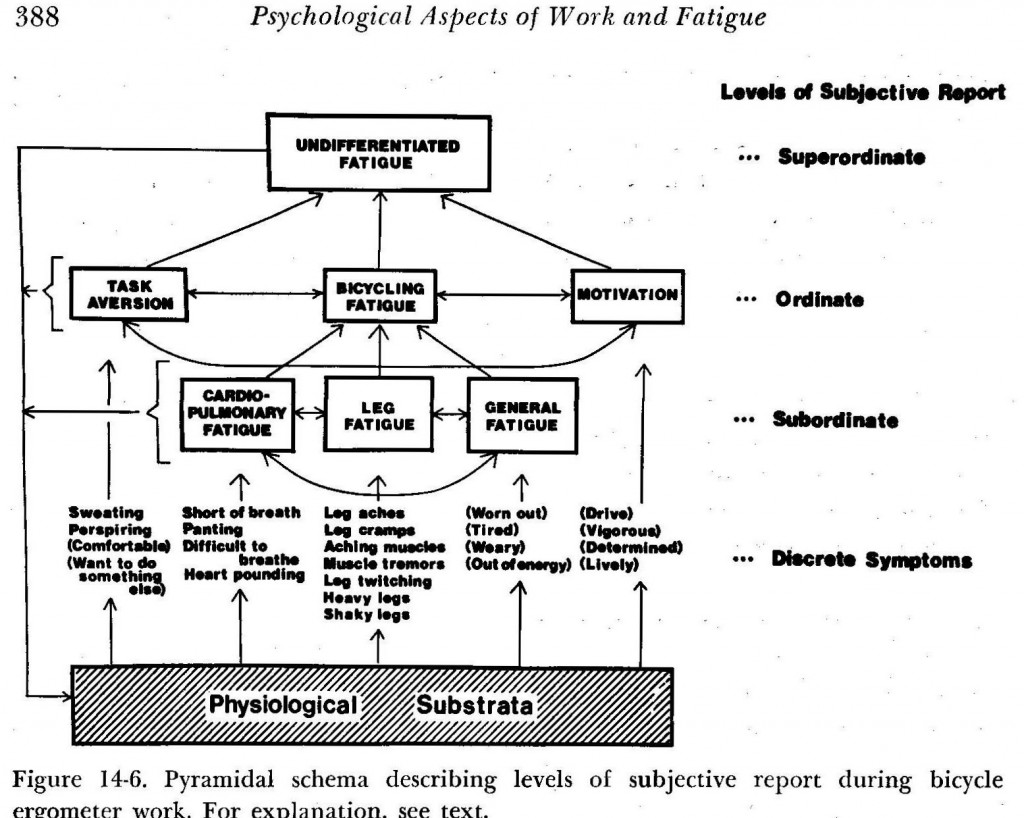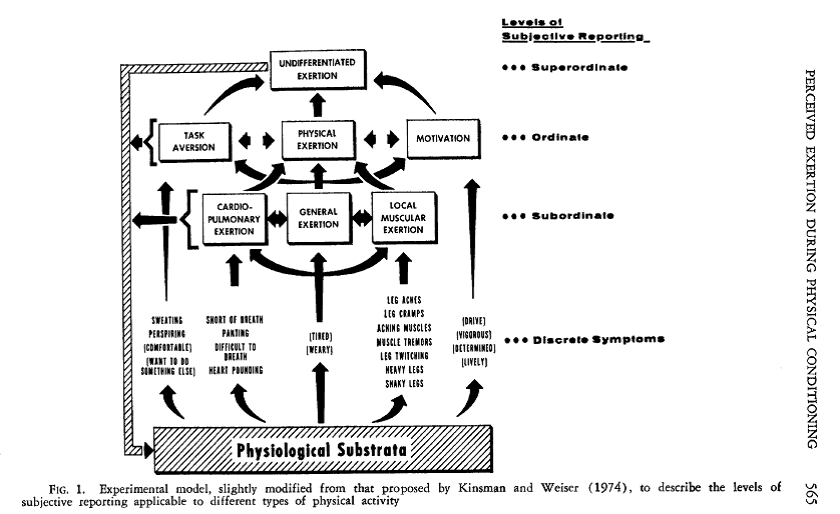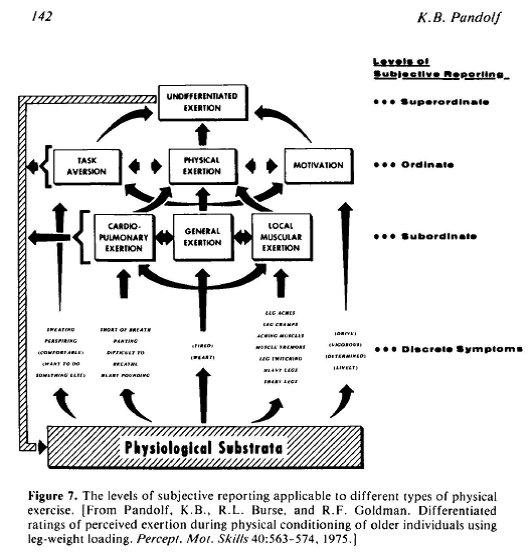Professor: First of all, thanks, Dr Rod Dishman, for cleaning up the Spherical Analysis for the symptom clusters (Dishman, 1994):
Student: Wow; no more overbearing, lines for the filling. Now I can see the cluster numbers clearly. Outstanding!
Professor: And now, how might these symptoms be the result of physiological processes? Here is a possible schema:
Figure 14-6. Pyramidal schema describing levels of symptom report during prolonged cycle ergometer work (from Kinsman & Weiser, 1976).
Click link to downlosd chapter: Kinsman Weiser Chapter 14 1976
Professor: After our research was ‘in press’ I remember sitting down in 1972 with Bob reviewing the research prepping to write the chapter. We noticed the number of very general and all-encompassing single dimension subjective qualities. “Aha,” said Bob. “These are only undifferentiated symptoms. Let’s lump together all the qualities together, like a Gestalt, and called them ‘Undifferentiated Fatigue‘.” Then we grouped out three Fatigue cluster into Bicycling Fatigue. After a while Bob remarked, “I think we have the ingredients for a pyramidal schema.” They were:
- Symptoms: “the report of subjective symptomatology, including undifferentiated fatigue, categories of symptoms, and discrete symptoms;”
- Physiological substrates: “the physiological substrata which is importantly altered during work;”
- Perceptual mechanisms: “the relationship between physiological factors and symptomatology during work.” (Kinsman & Weiser, 1976, p 387)
Student: You two integrated these into quite a hierarchy. Anyone discuss or use this chapter?
Professor: Well, Googling the name of the chapter produced 63 citations with six reported in 2008 or later. In 2002, Paddy Ekkekakis and Steve Petruzzello made kind comments in their chapter “Biofeedback in Exercise Psychology”. Kent Pandolf and colleagues had a 1974 draft of the chapter and modified the pyramidal schema by changing the labels replacing “Fatigue” with “Exertion” (1975):
Professor: At the 1975 ACSM Annual Meeting, Kent and I crossed paths, and I thanked him for grabbing onto the pyramidal concept. Over the next years, I shifted into pulmonary physiology and dyspnea research and later became a certified Program Director for Cardiopulmonary and Adult Fitness Programs.
In 1983, the yearly Exercise and Sport Sciences Review arrived in my mailbox. Low and behold there was the Pandolf Pyramidal Levels of Subjective Reporting to different types of physical exercise (Pandolf, 1983):
Student: AYE WHAT!? Is that kind of poet license what research is all about!?
Professor: Shrugging my shoulder is what I do about this. From most of the 1980s and on, I did a few studies about exertion, fatigue, and dyspnea. Yeah, this sage saddens me, and I can move on from the saga.
Next: it’s a fuzzy area between mechanisms for processing sensory signals first, into sensations, and then, into perceptions pain. So, next week the Stockholm presentation given in 1975 will review an attempt to clarify this fuzzy area.
References:
Dishman RK. (1994) Prescribing exercise intensity for healthy adults using perceived exertion. Medicine and Science in Sports and Exercise 26: 1087-1094.
Ekkekakis P, Petruzzello SJ. (2002) Biofeedback in exercise psychology. In B. Blumenstein, M. Bar-Eli, & G. Tenenbaum (Eds.), Brain and body in sport and exercise: Biofeedback application in performance enhancement . Chichester, England: John Wiley & Sons. pp. 77-100.
Kinsman, R. A., & Weiser, P. C. (1976) Subjective symptomatology during work and fatigue. In E. Simonson & P. C. Weiser (Eds.), Psychological aspects and physiological correlates of work and fatigue. Springfield, IL: Thomas, pp. 336-405.
Pandolf K. (1983) Advances in the study and application of perceived exertion. Exercise & Sport Sciences Reviews 11: 118-158.
Pandolf K, Burse RL, Goldman RF. (1975) Differentiated ratings of perceived exertion during physical conditioning of older individuals using leg-weight loading. Perceptual and Motor Skills 40: 563-574.



